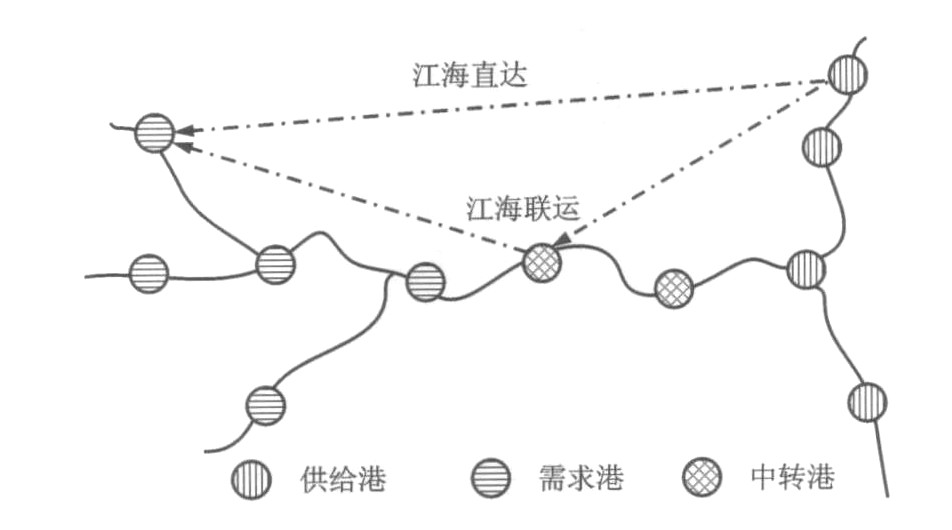Optimization model of dry bulk feright in Yangtze River based on river-sea transportation mode and investment constraint
-
摘要: 引入了江海直达运输模式和投资约束的概念, 对已有的长江干散货运输网络进行优化, 并比较了江海直达与江海联运2种运输模式的特点。根据中国内河航运成熟性市场的特质和航运企业滚动规划的经营特征, 以最小运营成本与最小船舶投资成本为目标函数, 建立了集成处理运输模式选择、航线配船和船型更新的模型。简化了模型的时间维度, 设计了基于背包问题的拉格朗日松弛算法, 并应用A集团数据求解模型。分析结果表明: 当以现行模式的航运总成本为基准点, 在引入江海联运模式后, 航运总成本可下降2%左右; 在引入江海直达运输模式后, 航运总成本的最大下降幅度超过8%, 但财务风险会增大; 当资金成本率为7%且不考虑投资约束时, 成本节约效应可提高16.2%, 但投资净预算将会上升60.1%。从最优航线配置可以看出, 在不同航线上, 江海直达与江海联运2种运输模式应协同使用。Abstract: The concepts of river-sea transportation mode and investment constraint were introduced, the existed transportation network of dry bulk freight in Yangtze River was optimized, and the characteristics of river-sea transportation mode and river-sea combined transportation mode were compared.According to the characteristic of mature market for inland shipping and the management feature of rolling planning for shipping enterprise in China, the minimum operation cost and the minimum ship investment cost were taken as objective functions, and the model that integrated transportation mode selection, ship assignment and ship type update was set up.The time dimension of the model was simplified, the Lagrangian relaxation algorithm based on knapsack problem was designed, and the data of group A were used to solve the model.Analysis result shows that while the total shipping cost of current mode is taken as a reference point, the total shipping cost can decrease by about 2% after using river-sea combined transportation mode.After using river-sea transportation mode, the maximum descent range is more than 8%, but the financial risk will increase.While the fund cost rate is 7% and the investment constraint is not considered, cost-reduction effect increases by 16.2%, but net investment budget will raise by 60.1%.From the configuration of optimal route, the river-sea transportation mode and river-sea combined transportation mode must be used together on different routes.
-
表 1 主要运输模式比较
Table 1. Comparison between main transportation modes
分类 江海联运 江海直达 运输方式 二程运输, 沿海供给港经中转港再换装转运到达内河需求港 一程运输, 由沿海供给港直接运达内河需求港 船型组成 海上航段采用沿海货轮, 内河航段采用长江货轮 全程采用江海两用船 优势 利用已有沿海货轮和长江货轮船型, 充分发挥沿海与长江货轮规模效应 减少中转的成本和损耗, 有利于发挥江海运一体化的协同效应 劣势 增加了中途换装和货物损耗费用, 运输周期较长 需要购置专用的江海两用船船型, 受长江航道、港口等限制 表 2 主要船型部分参数
Table 2. Partial parameters of main ship types
参数 近洋与沿海货轮 江海直达货轮 长江货轮 吨位/t 100 000 50 000 30 000 23 000 19 000 6 000 单位成本/[元·(t·km) -1] 0.039 0.040 0.041 0.042 0.043 0.050 运营固定成本与船价比/% 12 12 12 10 10 20 中转装卸成本与运输成本比/% 3 3 3 3 中转货损费用与运输成本比/% 2 2 2 2 表 3 结果比较
Table 3. Result comparison
规划期/年 净投资预算/亿元 累计折旧率 资金成本率 江海联运模式总成本节约比例/% 江海直达模式总成本节约比例/% 3 10 0.80 0.10 1.75 3.06 3 10 0.80 0.07 2.08 6.25 3 10 0.80 0.04 2.27 8.62 5 15 0.80 0.10 1.73 2.91 5 15 0.80 0.07 2.06 5.19 5 15 0.80 0.04 2.26 8.22 3 10 0.90 0.10 2.14 2.99 3 10 0.90 0.07 2.30 4.90 3 10 0.90 0.04 2.40 6.37 5 15 0.90 0.10 2.12 2.90 5 15 0.90 0.07 2.29 5.12 5 15 0.90 0.04 2.40 7.87 -
[1] KONINGS R, LUDEMA M. The competitiveness of the river-sea transport system: market perspectives on the United Kingdom-Germany corridor[J]. Journal of Transport Geography, 2000, 8(3): 221-228. doi: 10.1016/S0966-6923(00)00015-6 [2] CHARLES L. Sea-river shipping competitiveness and its geo-graphical market area for the Rhone-Saone corridor[J]. Journal of Transport Geography, 2008, 16(2): 100-116. doi: 10.1016/j.jtrangeo.2007.04.003 [3] 陈顺怀, 李俊敏, 王呈方. 北仑—武钢矿石进江江海直达驳运输船队优化[J]. 航海工程, 2001(4): 8-11. https://www.cnki.com.cn/Article/CJFDTOTAL-WHZC200104003.htmCHEN Shun-huai, LI Jun-min, WANG Cheng-fang. Optimal fleet for river-sea going transportation of ore on Beilun-Wuhan Route[J]. Ship and Ocean Engineering, 2001(4): 8-11. (in Chinese). https://www.cnki.com.cn/Article/CJFDTOTAL-WHZC200104003.htm [4] 秦金娣. 武钢进口铁矿石物流系统优化研究[D]. 武汉: 华中科技大学, 2006.QIN Jin-di. Study on the optimization of logistics system about imported iron ore in WISCO[D]. Wuhan: Huazhong University of Science and Technology, 2006. (in Chinese). [5] 朱丽丽. 长江中下游进口铁矿石运输模式比较分析[J]. 综合运输, 2008(7): 70-71. https://www.cnki.com.cn/Article/CJFDTOTAL-YSZH200807020.htmZHU Li-li. Comparative analysis on shipping modes of iron ore in the midstream and downstream of Yangtze River[J]. Comprehensive Transportation, 2008(7): 70-71. (in Chinese). https://www.cnki.com.cn/Article/CJFDTOTAL-YSZH200807020.htm [6] RISSOAN J P. River-sea navigation in Europe[J]. Journal of Transport Geography, 1994, 2(2): 131-142. doi: 10.1016/0966-6923(94)90019-1 [7] 衡强. 长江至洋山港区江海联运发展战略模式研究[D]. 南京: 河海大学, 2007.HENG Qiang. An analysis on the strategy management of transportation mode from Yangtze River to Yangshan Port[D]. Nanjing: Hohai University, 2007. (in Chinese). [8] CHRISTIANSEN M, FAGERHOLT K, RONEN D. Ship routing and scheduling: status and perspectives[J]. Trans-portation Science, 2004, 38(1): 1-18. doi: 10.1287/trsc.1030.0036 [9] 杨秋平, 谢新连, 赵家保. 船队规划研究现状与动态[J]. 交通运输工程学报, 2010, 10(4): 85-90. doi: 10.3969/j.issn.1671-1637.2010.04.014YANG Qiu-ping, XIE Xin-lian, ZHAO Jia-bao. Research status and prospect of fleet planning[J]. Journal of Traffic and Transportation Engineering, 2010, 10(4): 85-90. (in Chinese). doi: 10.3969/j.issn.1671-1637.2010.04.014 [10] JAIKUMAR M, SOLOMON M M. The tug fleet size prob-lem for barge line operations: apolynomial algorithm[J]. Transportation Science, 1987, 21(4): 264-272. doi: 10.1287/trsc.21.4.264 [11] 谢新连, 李树范, 纪卓尚, 等. 船队规划的线性模型研究与应用[J]. 中国造船, 1989, 30(3): 59-66. https://www.cnki.com.cn/Article/CJFDTOTAL-ZGZC198903005.htmXIE Xin-lian, LI Shu-fan, JI Zhuo-shang, et al. Study and application on the linear model of fleet planning[J]. Ship-building of China, 1989, 30(3): 59-66. (in Chinese). https://www.cnki.com.cn/Article/CJFDTOTAL-ZGZC198903005.htm [12] 苏绍娟. 不确定动态船队规划的数学模型研究[J]. 中国航海, 2008, 31(2): 158-161. https://www.cnki.com.cn/Article/CJFDTOTAL-ZGHH200802015.htmSU Shao-juan. Mathematical model study on uncertain multi-stage fleet planning[J]. Navigation of China, 2008, 31(2): 158-161. (in Chinese). https://www.cnki.com.cn/Article/CJFDTOTAL-ZGHH200802015.htm [13] MEHREZ A, HUNG M S, AHN B H. An industrial ocean-cargo shipping problem[J]. Decision Science, 1995, 26(3): 395-423. doi: 10.1111/j.1540-5915.1995.tb01434.x [14] AGARWAL R, ERGUN Ö. Ship scheduling and network design for cargo routing in liner shipping[J]. Transportation Science, 2008, 42(2): 175-196. doi: 10.1287/trsc.1070.0205 [15] XIE Xin-lian, WANG Teng-fei, CHEN Dai-song. A dynamic model and algorithm for fleet planning[J]. Maritime Policy and Management, 2000, 27(1): 53-63. https://www.researchgate.net/publication/233576921_A_dynamic_model_and_algorithm_for_fleet_planning [16] NICHOLSON T A J, PULLEN R D. Dynamic programming applied to ship fleet management[J]. Operational Research Quarterly, 1971, 22(3): 211-220. doi: 10.1057/jors.1971.55 -





 下载:
下载:



